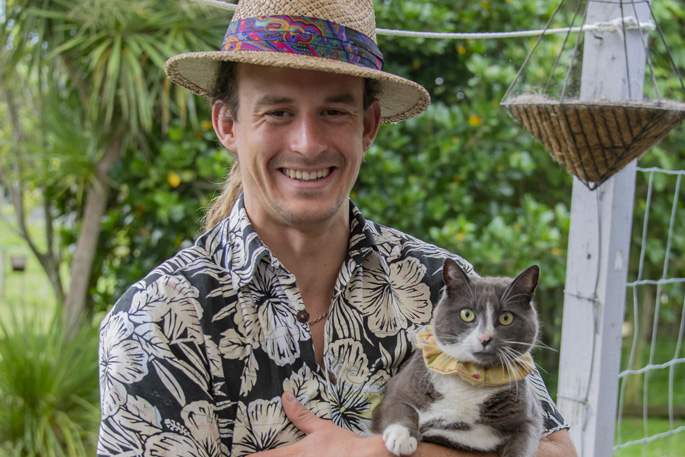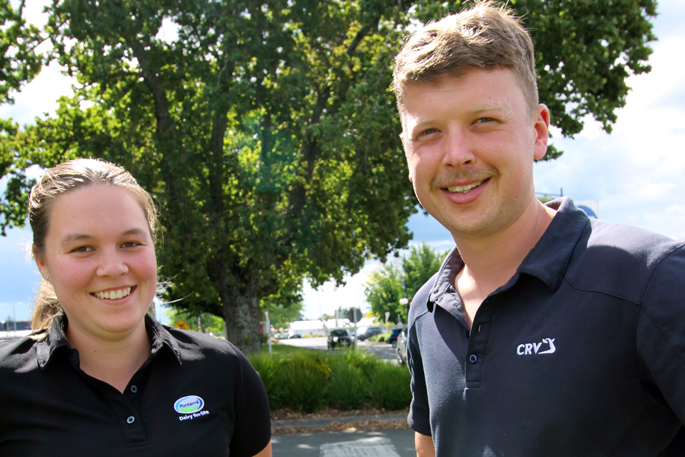Biodiversity ranger Duncan Mackay volunteered for three years with the Karioi: Maunga ki te Moana project, before taking a 24-hours per week paid position with A Rocha Aotearoa NZ.
This is a partner organisation working with hapu, landowners, other non-government organisations and community volunteers, to restore biodiversity on the mountain – or maunga – and around the town of Raglan.
The long-term aim is to restore Karioi Maunga as a seabird mountain.
The project is funded by private donations, grants, Waikato Regional Council, WWF-NZ and the Department of Conservation.
Duncan’s role is varied, ranging from education to trapping, track maintenance to monitoring species, all of which means he has plenty of reason to spend hours up on his beloved maunga.
“Trapping is probably a bit of a grisly part of the job,” says the 30-year-old. “But we are talking about invasive pests that are destroying our natural ecosystem.”
The 1300 hectares of DOC land and 500 hectares of hapu land on Mount Karioi, the familiar ‘Sleeping Lady’ mountain of Raglan, has around 1000 active traps on it.
“We catch all sorts of predators including rats, mice, weasels, stoats, possums, hedgehogs and feral cats,” says Duncan.
Feral cats
The feral cats are caught live and taken to the vet to be euthanised. This is because nearer the town domestic cats sometimes enter the traps and they need to be freed safely.
Duncan is not afraid to discuss the controversial subject of domestic cats being one of the largest threats to native birds. A cat lover himself, he looks for solutions.
“For an older person, a cat often helps with loneliness and provides companionship.
“The cat should be neutered, vaccinated, well fed, kept in at night, and wear a collar to reduce its chances when hunting.”
Duncan makes special ruff collars that are bright yellow, have reflective edges, and loud bells. He sells them at the vet clinic in Raglan and his own cat ‘Tequila’ wears one at all times.
“The combination of colour and noise makes it very hard for a cat to hide and stalk prey. My cat has gone from catching several birds a week to catching several a year.”
Duncan has a Controlled Substances Licence and doesn’t shy away from the subject of 1080 either.
“Nobody agrees with poisoning paradise, but everyone agrees we have to save paradise and that is currently the best option.
“If this statement empowers someone to find an alternative; that would be worthwhile.”
Grey-faced petrel
Five years ago, a remnant population of Grey-faced petrel, or Oi, was found nesting in the bush just outside Raglan. Duncan and the team are very excited about the discovery and are actively monitoring and protecting the colony.
“Historically, the maunga would have had thousands of pairs of these taonga – highly prized by Maori – birds nesting on it,” says Duncan.
“In fact, Karioi was a seabird mountain, with 11 different species of seabirds literally living in every habitat from the beach to the mountain top.
“Last year we had seven Oi chicks, and this year we have around 18 active burrows with potential chicks in them. This is the start of a very long-term project.”
The project is rolling out forest bird counts, and people are reporting more and more forest birds on the mountain.
Surfboards and trees
Duncan spends time educating students and taking groups onto the mountain. Under the Manaaki Ao Earthcare Project, NCEA credits can be obtained through trapping.
On top of his ranger work, Duncan works 32 hours a week making surfboards, finds time to surf, and still manages to grow native trees.
On his three-acre lifestyle block just outside Raglan he’s planted 2000 trees, and is planning to build an eco-friendly home on the land.
Currently, he lives close to the surf beach at Raglan, and has shade cloth-covered structures all over the garden. Each one houses seedlings of native trees, sown from donated seeds, and all at different stages of development.
These seedlings are given away, used in community planting and riparian planting.
“I think holistically about the ecosystem; what I affect, affects everything else.
“I see myself as a janitor, I mop up and lock up, but I can’t control the ecosystem.”
To find out more, see: www.karioimaunga.co.nz




0 Comments
Leave a Comment